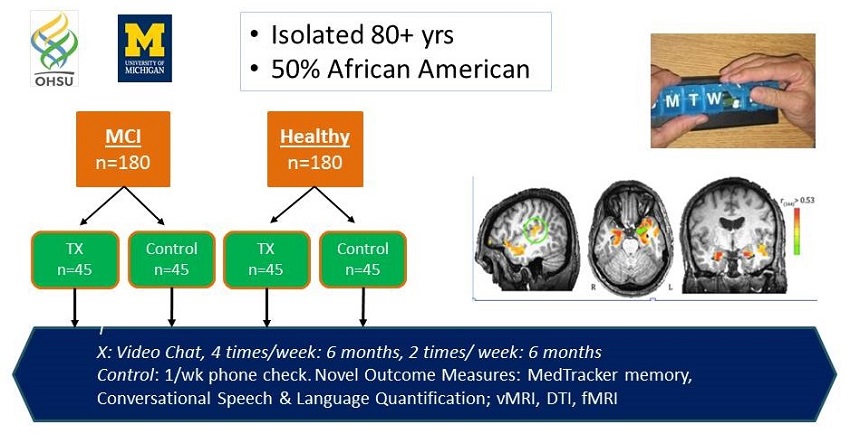Monday, January 28, 2019
Printer Friendly Version in PDF Format (18 PDF pages)
Technology to Advance Assessment & Interventions for Dementia
Jeffrey Kaye
Layton Professor of Neurology & Biomedical Engineering
ORCATECH - Oregon Center for Aging & Technology
NIA - Layton Aging & Alzheimer's Disease Center
http://www.orcatech.org; http://www.carthome.org
Contemporary Assessment
"How long have you been here? She seems to be trying to remember. Three weeks. What is this? I show her a pencil. A pen. A purse, key, diary and cigar are identified correctly. ... When objects are shown to her, she does not remember after a short time which objects have been shown..."
--- A. Alzheimer, Nov. 6, 1901
Still crazy after all these years...
Detecting Meaningful Change
 |
 |
High variability in cognitive tests
-- ADNI Memory Composite Dodge et. al., 2014 |
High variability in self-report measures
-- UCLA Loneliness Scale
Austin et al., 2016 |
The way it should be...
Pervasive Computing Technologies
- Transform the ability to detect meaningful change
- Increase the speed or efficiency of clinical trials and dementia research in general
- Provide new fundamental insights into human biology and behavior
Transform the ability to detect meaningful change
Challenges to developing new therapies
Increase the speed or efficiency of clinical trials and dementia research in general
| MCI Prevention Trial -- Sample Size Estimates |
| |
Current Method |
Continuous Measures |
| |
LM Delayed Recall* |
Computer Use** |
Walking Speed** |
| SAMPLE SIZE TO SHOW 50% EFFECT |
688 |
10 |
94 |
| SAMPLE SIZE TO SHOW 30% EFFECT |
1912 |
26 |
262 |
| SAMPLE SIZE TO SHOW 20% EFFECT |
4300 |
58 |
588 |
| Dodge, et al., PLoS One, 2015 |
- Reduces required sample size and/or time to identify meaningful change.
- Reduces exposure to harm (fewer needed/ fewer exposed)
- More precise estimates of the trajectory of change; allows for intra-individual predictions.
- Provides the opportunity to substantially improve efficiency and inform go/no-go decisions of trials.
Provide new insights into human biology and behavior
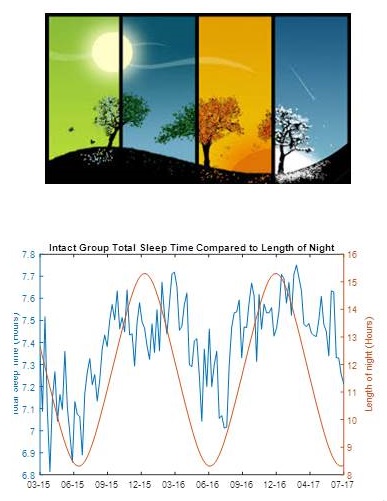 |
Disrupted Infradian Rhythms in MCI
Reynolds, et al., 2017 |
How? NIA - Technology Agnostic R & D Platform ORCATECH Life Laboratory + CART
 |
| Kaye et al. J of Gerontol, 2011; Lyons et al. Frontiers in Aging Neurosci, 2015; Kaye et al. J of Visualized Experiments, 2018 |
ORCATECH - CART End-to-End System
CART - Collaborative Aging Research Using Technology http://www.carthome.org
- Established to address needed research capability for evidence building (facilitated by technology) in aging research.
- Goal: Design and implement a scalable, disseminated technology system ('platform') for more effective aging research, ultimately deployable to 10,000+ homes
- Focus on diversity, technology agnosticism, "future-proofing", use case flexibility, sustainability, facilitating secure data sharing.
- Interagency U2C (U2CAG054397) with NIH (NIA, NIBIB, NCI, NINDS, NINR, NCATS, OBSSR,) and VA
- Research Team: PI, Jeffrey Kaye, ORCATECH/Oregon Health & Science University; Nina Silverberg, NIA; Collaborators: Intel, U. Miami, Cornell, Rush, OSU, U. Penn, VA VISN 20
CART + ORCATECH Sites/Homes in U.S. and Canada
Assessments - Examples
Developing PD and Tx Response
Physical Activity and Mobility Behaviors
| Room activity distributions differentiating MCI vs not MCI |
| Room |
Bedroom |
Bathroom |
Kitchen |
Living Room |
Combined |
| F0.5 Score* |
0.842 |
0.829 |
0.813 |
0.826 |
0.856 |
| *F0.5 Scores window size w = 20 weeks; slide size = 4 weeks (with leave-one-subject-out cross validation) |
| |
Trajectories of gait speed over time |
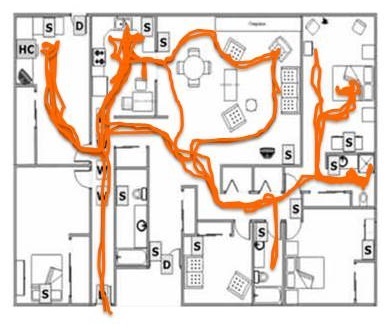 |
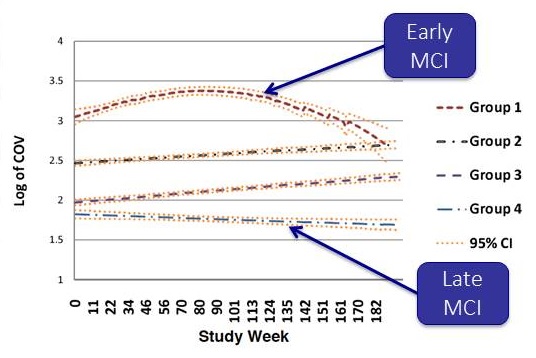 |
| Akl et al. Journal of Ambient Intelligence and Smart Environments, 2015 |
Dodge, et al. Neurology, 2012 |
Chronobiological Behavior
| No Differences Between Groups in Self-Report Measures |
| Self-Report Measure |
Intact |
aMCI |
naMCI |
P value |
| Subjective Daytime Sleepiness |
1.8 ± 0.2 |
1.5 ± 0.3 |
2.0 ± 0.3 |
0.69 |
| Subjective Insomnia |
1.3 ± 0.2 |
0.8 ± 0.3 |
1.6 ± 0.3 |
0.21 |
| Subjective Restlessness |
1.0 ± 0.1 |
0.4 ± 0.3 |
0.7 ± 0.2 |
0.34 |
| Times up at night |
1.1 ± 0.1 |
1.0 ± 0.3 |
1.0 ± 0.2 |
0.77 |
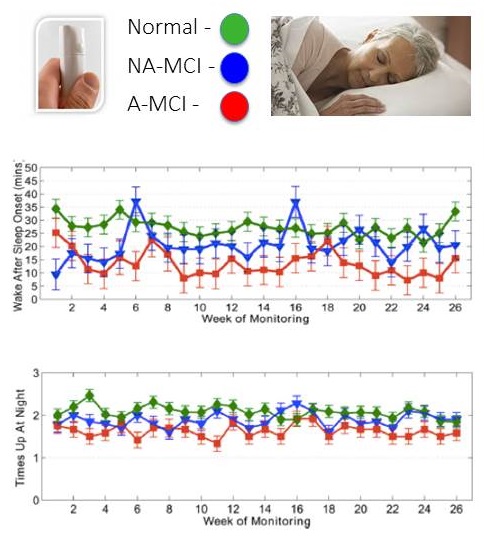 |
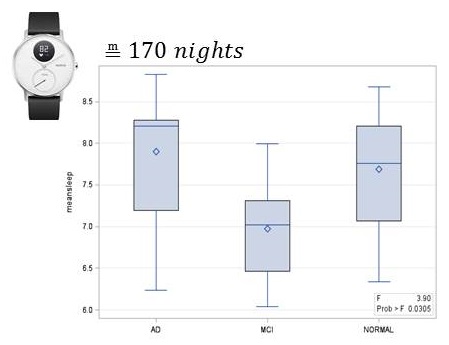 |
Hayes, et al. Alzheimer Dis Assoc Disord. 2014
Hayes, et al. IEEE Eng Med Biol Soc, 2010 |
|
Cognition, Behavior, Motor Function: Computer Use
 |
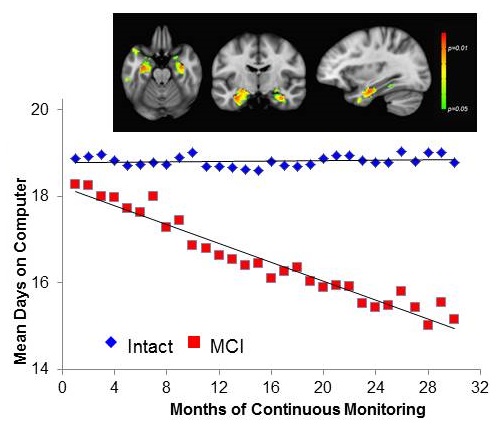 |
| Kaye, et al. Alzheimers Dement. 2014; Silbert et al., Alzheimers Dement, 2015; Seelye et al. Alzheimers Dement.: Diagnosis, Assessment & Disease Monitoring, 2015; Seelye et al. Alzheimer's Disease & Assoc. Disorders, 2015; Seelye et al., Alzheimer & Dementia, 2018 |
|
| Table 4. Associations between cognitive status and mouse movement variability derived from one week of data |
| Covariate |
Outcome, movement curvature (IQR_K) |
Outcome, time spent idling (IQR_Idle) |
| Coefficient |
P value |
Coefficient |
P value |
| MCI (reference: cognitively intact group) |
0.013 |
.008** |
386.8 |
.04* |
| Age (y) |
-0.001 |
.03* |
-15.0 |
.31 |
| Education (y) |
0.002 |
.05 |
-12.4| |
.70 |
Abbreviations: IQR, interquartile range; MCI, mild cognitive impairment.
NOTE: *P <.05, **P <.01. |
Digital biomarkers and Braak Score
Digital biomarkers and Plaque Score
Digital functional activity composite relative to plaque score
| Digital Composite = Mobility + Cognition + Sleep + Socialization |
 |
Technologies advancing dementia intervention research - Examples
Ambient Independence Measures (AIMS) for Guiding Care Transitions (R01AG042191)
- During the three years of study -- low staff engagement:
- 11/26 consented staff members logged in at least once to the activity dashboard.
- Staff "page views", that is, number of pages of data looked at, ranged from 4-211 over the duration of data collection.
- Mean seconds spent on a particular page view was 36 (range, 1-750)
- Across 5 monthly email surveys, response rate of 31% (23/73).
Ambient Independence Measures Guiding Care Transitions
- Bottom Line:
- Technology worked well with unique metrics acting both as assessment and intervention
- Inconclusive results -- despite high engagement and enthusiasm at entry and booster sessions, inadequate engagement of staff across 7 communities
- Care system designed for crisis intervention
- Realizing proactive action on trend data is an unmet need
Objective in-home monitoring to identify meaningful behaviours changing during a loneliness intervention
| Intervention: "Capturing Time: Journaling Your Journey" -- designed to improve negative emotions such as loneliness, depression, anxiety, and low self-esteem. |
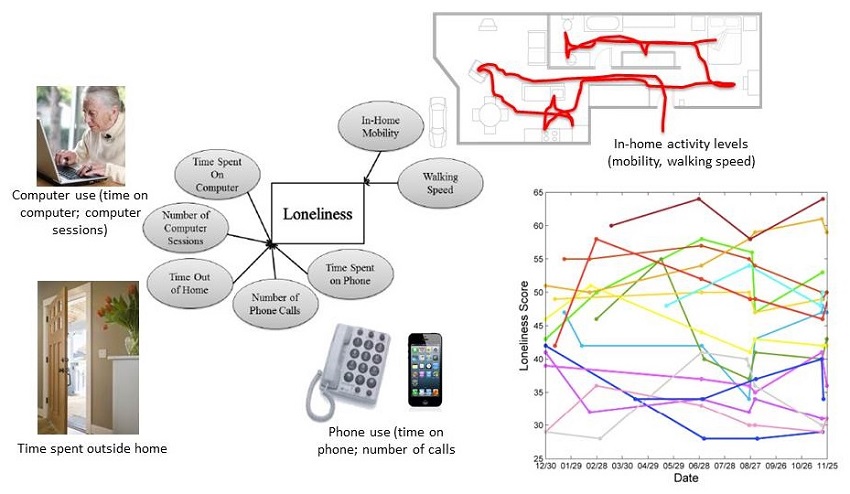 |
| Austin et al. IEEE Journal of Translational Engineering in Health Medicine 2016 |
Capturing Time: digital biomarker results
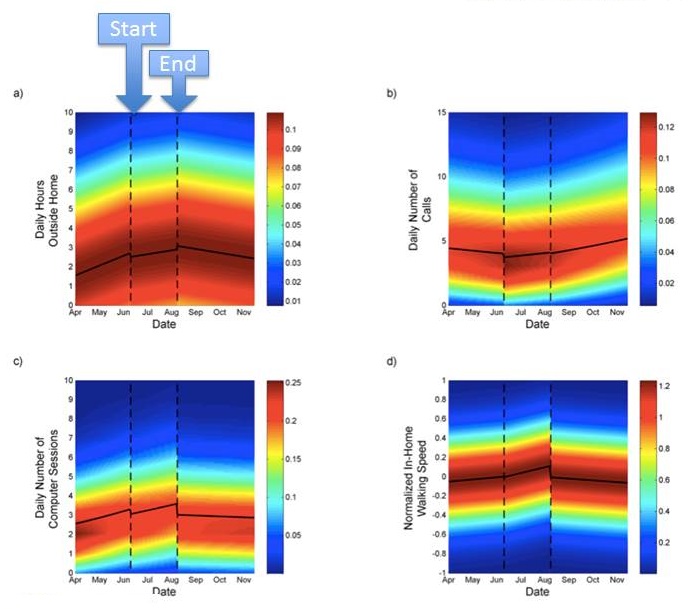 |
| Austin, et al. 2018 |
 Loneliness (p<0.05) by an average of 2.2 ± 3 points.
Loneliness (p<0.05) by an average of 2.2 ± 3 points. Time out-of-home (ß=0.96, p<0.01)
Time out-of-home (ß=0.96, p<0.01) Number of computer sessions (IRR=1.196, p<0.01)
Number of computer sessions (IRR=1.196, p<0.01) Walking speed over time (ß = 0.002, p<0.01).
Walking speed over time (ß = 0.002, p<0.01). Total phone calls, after intervention (IRR=1.003, p<0.01)
Total phone calls, after intervention (IRR=1.003, p<0.01)
Multi-modal Brain Health Program - SHARP: Sharing History through Active Reminiscence and Photo-imagery
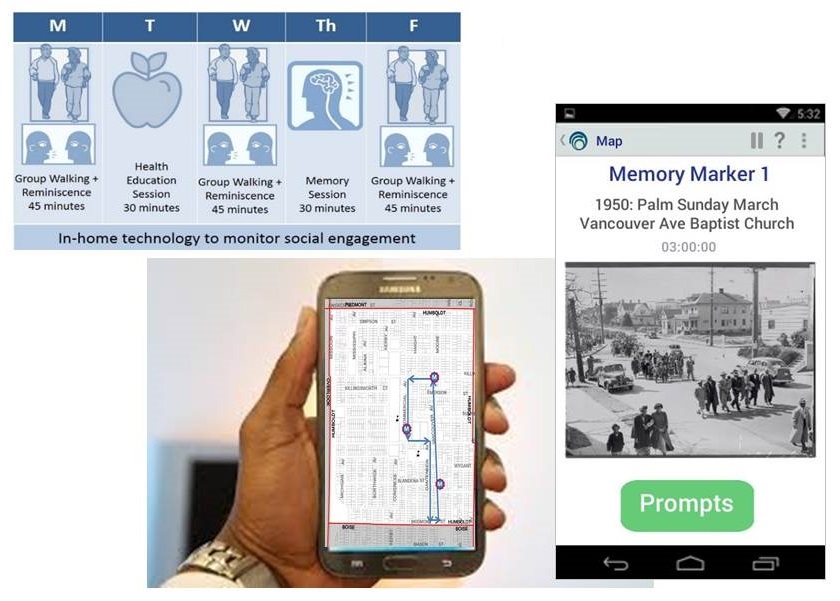 |
PI: Raina Croff; NIA: P30AG008017, P30AG024978, and Alzheimer's Association
Croff R, et al. The Gerontologist, 2018. |
The "Social Engagement Study" (H. Dodge, PI)
Active, Frequent Assessments & Interventions Delivered Everyday - an RCT to Increase Social Interaction in MCI Using Home-based Technologies
- 6 week RCT of daily 30 min video chats using Internet connected personal computers with a webcam vs. weekly brief phone interview
- N = 86; 80.5 ± 6.8 years; MCI & Normal Cognition
- 89% of all possible sessions completed; Exceptional adherence -- no drop-out
|
 |
Dodge et al. Alzheimer's & Dementia: Translational Res. & Clinical Interventions, 2015
Dodge et al., Current Alzheimer's Disease, 2015 |
Computer Use: Social Markers of Cognitive Function
| Table 4. Average number of words grouped into LIWC categories |
| LIWC cat. |
Communication |
Swear |
Anger |
Fillers |
Family |
| Avg. num. in MCI |
46.4 |
7.14 |
37 |
101.5 |
31.14 |
| Avg. num. in intact |
38.7 |
4.8 |
49.8 |
141.6 |
41.8 |
| p-value |
0.002 |
0.005 |
0.054 |
0.067 |
0.08 |
- MCI participants generate a greater proportion of words (2985 vs. 2423 words on average) out of the total number of words during the conversation sessions (p=0.03).
- Logistic regression models showed the ROC AUC of identifying MCI (vs. normals) was 0.71 (95% Confidence Interval: 0.54 - 0.89) when average proportion of word counts spoken by subjects was included in the model.
|
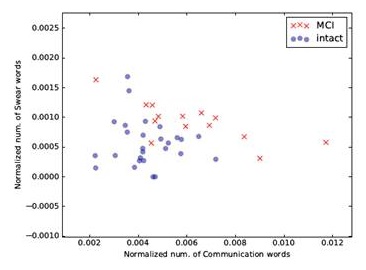 |
| Dodge et al. Current Alzheimer Res. 2015 Asgari et al. Alzheimer's & Dementia: Translational Research & Clinical Interventions, 2017 |
I-CONECT: Internet-based Conversational Engagement Clinical Trials
(PI: Dodge NIA R01AG051628; NIA R01AG056102)
Teledementia Care: Direct to Home Assessment & Care
- Alzheimer's Care via Telemedicine -- Establishing the Reliability of Telemedicine-based Measures
- STAR-C Adapted Telemedicine Intervention
|
 |
| Lindauer et al. Dementia Care Comes Home: Patient and Caregiver Assessment via Telemedicine. Gerontologist, 2017. |
EVALUATE - AD
Ecologically Valid, Ambient, Longitudinal and Unbiased Assessment of Treatment Efficacy in Alzheimer's Disease
- Longitudinal naturalistic observational cohort study spanning up to 18 months
- Goal: New Trial Paradigm - Establish Digital Biomarkers that are sensitive to clinical change associated with conventional AD TXs
- ORCATECH platform
- Sixty subjects: 30 patients/30 care partners (30 households)
- NIA / Merck Funding
| Week |
0 |
13 |
26 |
39 |
52 |
65 |
78 |
| Visit Type |
Screening |
Online |
Phone |
Online |
M12 |
Online |
M18 |
| Consent |
X |
|
|
|
|
|
|
| Personal & Family History Questionnaire |
X |
|
|
|
X |
|
X |
| MMSE |
X |
|
|
|
X |
|
X |
| ISAAC Technology Use Survey |
X |
|
|
|
X |
|
X |
| Tech & Computer Experience and Proficiency Questionnaires |
X |
|
|
|
X |
|
|
| Geriatric Depression Scale Short Form (GDS-SF) |
X |
|
|
|
X |
|
X |
| Zarit Burden Interview (ZBI-12) |
X |
X |
X |
X |
X |
X |
X |
| Functional Assessment Questionnaire (FAQ) |
X |
X |
X |
X |
X |
X |
X |
| Neuropsychiatric Inventory Questionnaire (NPI-Q) |
X |
X |
X |
X |
X |
X |
X |
| Pittsburgh Sleep Quality Assessment (PSQA) |
X |
|
|
|
X |
|
X |
| ORCATECH Health & Life Activity Form |
Weekly for duration of study |
| Caregiving: Time out of home/Time alone in home/Time in same room with partner/Time together in bathroom |
Assessed continuously |
| Physical capacity/Mobility: Total daily activity/Mobility/Step count/Walking speed/Time in locations |
Assessed continuously |
| Sleep: Time up/Time in Bed/Times Up at Night/Restlessness/Sleep Duration |
Assessed daily |
EVALUATE - AD
Couples & Caregiving Analysis: Time spent together
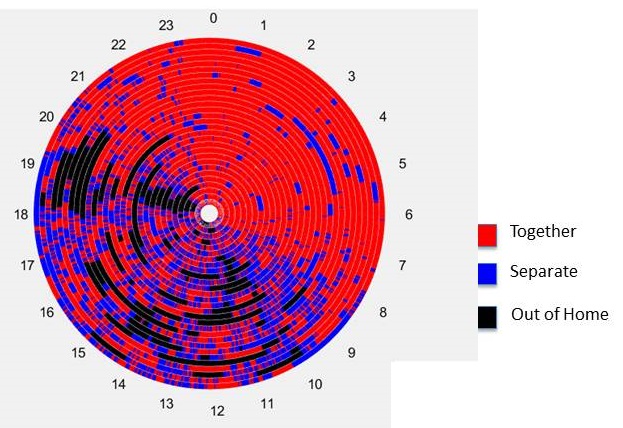 |
|
Together: 1285 minutes (21.4 hrs/day)
Apart: 155 minutes (2.6 hrs/day)
Reynolds et al., 2017 unpublished
Thomas et al., AAIC 2017
|
Digital Biomarkers in Later Stage Dementia Interventions
- ADCS PEACE-AD RCT: Prazocin for Agitation in AD RCT (Pis: Peskind & Raskin; Lim, Reynolds, Kaye)
- Digital Agitation Assessment - Activity levels monitored continuously during entire 12-wk titration study using wrist actigraphy. Continuous monitoring critical as study employs a flexible dose titration schedule, and the use of rescue medication.
- MODERATE - Monitoring Dementia-related Agitation using Technology-assisted Evaluations -
- Multiple sensors used to examine the effects of environment on dementia-associated behaviors.
Thank you!
Please Collaborate -- Your Research Here!
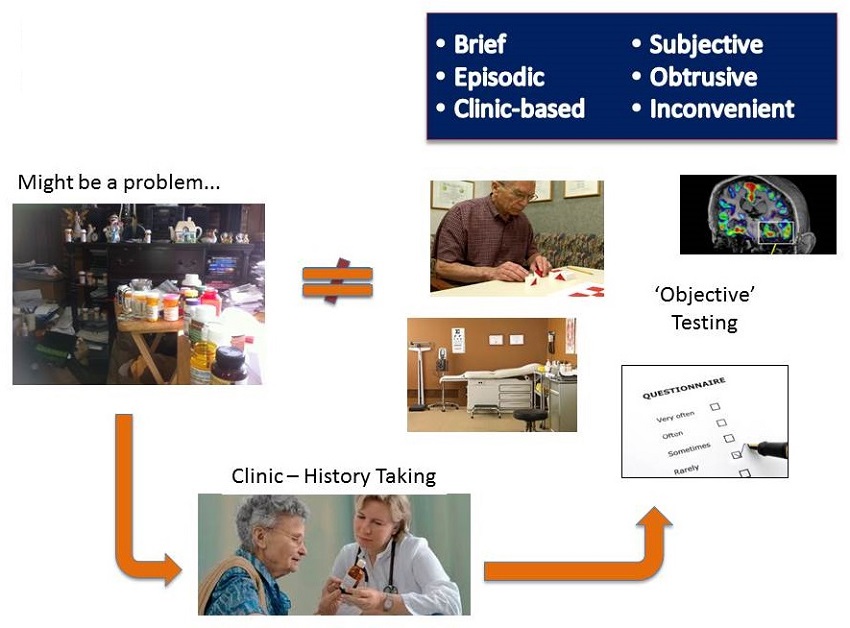


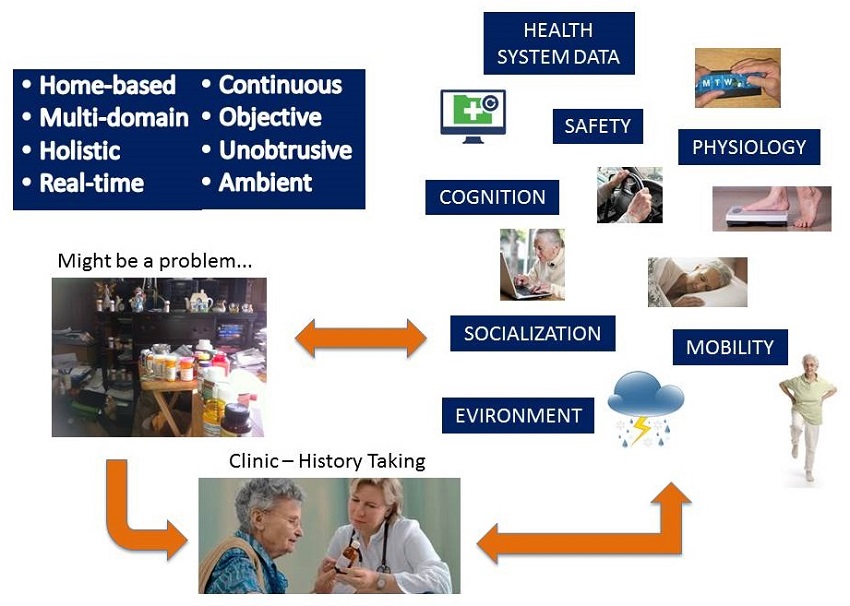




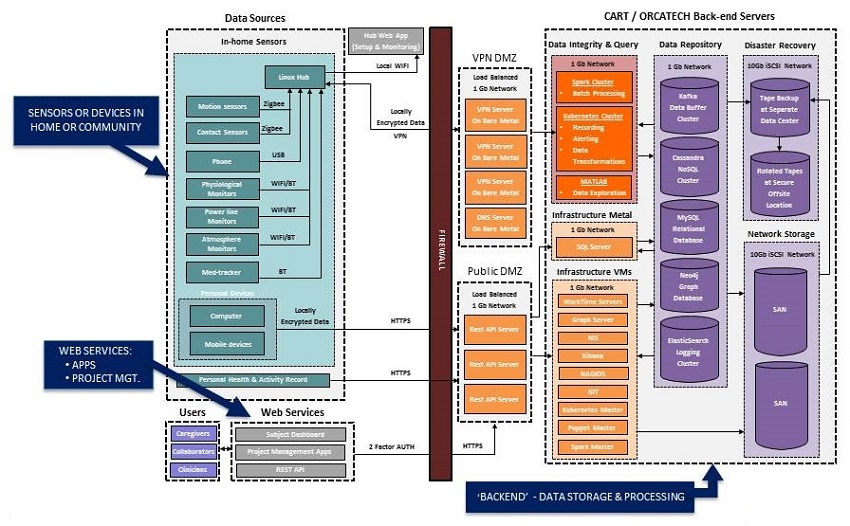

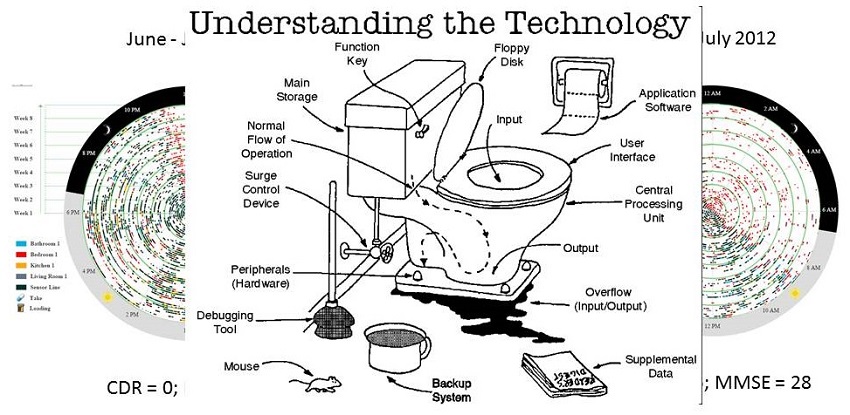
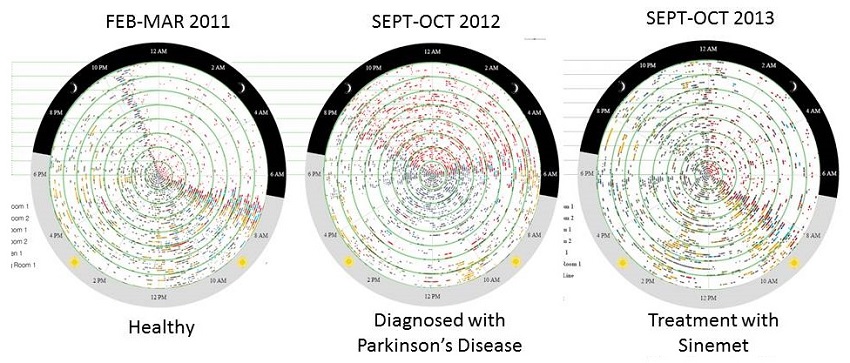










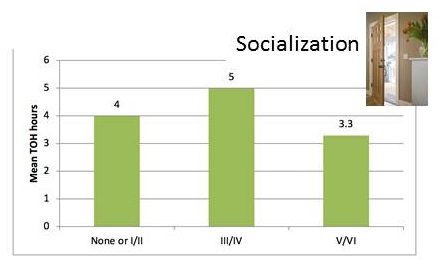

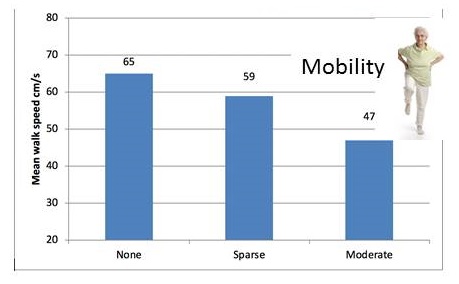

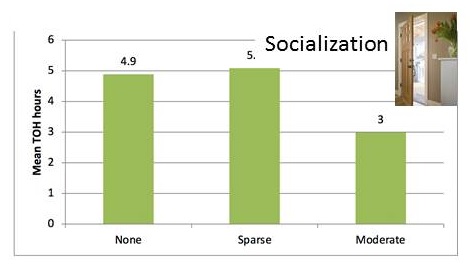

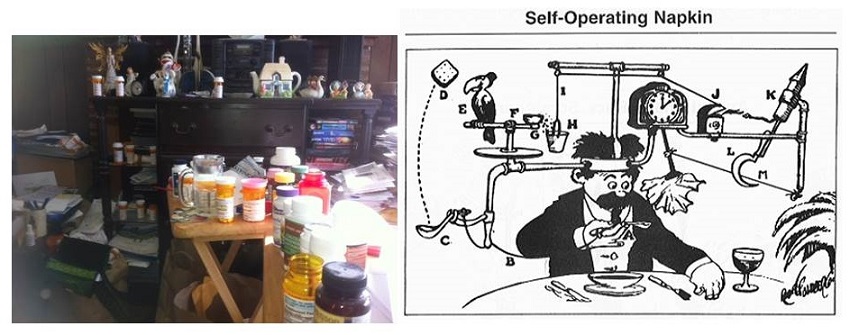


 Loneliness (p<0.05) by an average of 2.2 ± 3 points.
Loneliness (p<0.05) by an average of 2.2 ± 3 points. Time out-of-home (ß=0.96, p<0.01)
Time out-of-home (ß=0.96, p<0.01) Number of computer sessions (IRR=1.196, p<0.01)
Number of computer sessions (IRR=1.196, p<0.01) Walking speed over time (ß = 0.002, p<0.01).
Walking speed over time (ß = 0.002, p<0.01). Total phone calls, after intervention (IRR=1.003, p<0.01)
Total phone calls, after intervention (IRR=1.003, p<0.01)


